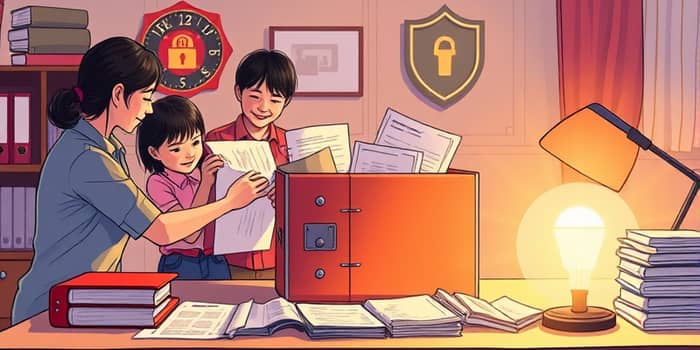Imagine waking to an urgent alert: a wildfire approaching your neighborhood. In the rush, you grab your emergency kit, confidently knowing your essential papers are safe and accessible. This isn’t a distant fantasy—it’s the outcome of careful preparation.
In this guide, you’ll learn how to assemble, organize, and secure your most critical documents, ensuring you can respond swiftly and confidently when every minute counts.
Why Financial Preparedness Matters
An unexpected crisis—whether a natural disaster, fire, or medical emergency—can upend your world in moments. During such times, having quick access to vital paperwork becomes a lifeline. Insurance companies, relief agencies, and government programs all require documentation to process claims and disburse aid.
Without proof of identity, residence, or ownership, you may face prolonged delays, denied claims, or legal hurdles that compound your stress. A well-organized kit gives you a decisive advantage, translating into reduced stress and faster recovery for you and your family.
Moreover, the act of preparing these documents fosters peace of mind. When you know exactly where to find your tax returns, property deeds, or insurance policies, you replace uncertainty with control.
The EFFAK Method: Four Fundamental Steps
FEMA’s Emergency Financial First Aid Kit (EFFAK) methodology offers a powerful framework. Follow these steps to build and maintain your personal kit:
- Assess and Compile: Use a detailed checklist to gather essential documents. Reach out to government agencies and financial institutions for certified copies if originals are missing.
- Safely Store Documents: Place physical files in a fireproof, waterproof safe deposit box and store encrypted digital copies in multiple locations.
- Keep Information Up-to-Date: Schedule annual reviews. Update records after life events like marriage, a new home purchase, or the birth of a child. Shred outdated sensitive papers responsibly.
- Ensure Accessibility: Share your kit’s location and any necessary passwords with trusted contacts, so they can assist if you are unavailable.
Key Documents and Records to Include
Your emergency kit should encompass categories that cover every aspect of your financial life. Here is a comprehensive sample checklist:
Organize these items in clearly labeled folders—both physical and digital. Consistent labeling accelerates retrieval during high-pressure situations.
Organizing and Storing Your Emergency Kit
Begin with a durable binder or a portable, water-resistant file box. Opt for a water-tight, fireproof container or a safety deposit box at your bank for irreplaceable originals. Simultaneously, scan all documents at high resolution and encrypt them using strong passwords.
Consider using a secure password manager to store login details for online accounts. Keep one digital backup on an encrypted USB drive stored off-site—perhaps at a trusted friend’s home. Regularly test your backups to ensure you can decrypt and access files when necessary.
Maintaining and Updating Your Kit
An emergency kit is never "complete." It requires ongoing attention. Choose a recurring date—like the start of each year—to review and refresh your documents. Replace expired IDs, update insurance policies, and add records of new assets.
- Review Annually: Check expiration dates and policy renewals.
- After Major Events: Add marriage certificates, new property deeds, or retirement account statements.
- Shred and Replace: Dispose of outdated information with a cross-cut shredder.
This proactive habit ensures your kit remains a reliable resource, not a dusty archive.
Digital Security and Redundancy
Digital storage introduces vulnerabilities alongside convenience. Safeguard your digital files by enabling two-factor authentication on all cloud services and password managers. Encrypt each file with robust standards, and avoid using obvious passwords.
Maintain at least one off-site backup—either a secure cloud service with strong encryption protocols or an encrypted USB drive in a separate physical location. Test your access periodically to confirm that you can retrieve and decrypt your records under stress.
This comprehensive emergency preparedness approach defends against both physical and cyber risks, ensuring your data remains intact no matter what.
Emergency Contacts and Action Plan
A list of reliable contacts and a clear action plan complement your document kit. Keep this information in both physical and digital formats for quick reference.
- Financial Institutions: Bank and credit union customer service lines with account numbers.
- Insurance Providers: Policy numbers and agent/claims contact details.
- Legal and Medical Advisors: Attorney, physician, and healthcare facility phone numbers.
- Family and Friends: Trusted relatives’ and neighbors’ contact information.
With this roadmap, you can prioritize actions and reach support networks without delay.
Real-World Examples: Learning from Past Disasters
After Hurricane Katrina, many residents could not access disaster aid because they lacked proof of residence or ownership. FEMA required specific documents, and delays in producing them left families without resources for weeks.
During the COVID-19 crisis, individuals with digitally accessible tax returns, pay stubs, and benefit records managed unemployment claims and stimulus payments far more efficiently than those who depended solely on paper files.
These examples underscore a vital truth: preparedness is not about predicting the future but equipping yourself to respond with speed and confidence.
Building Resilience Through Preparedness
Emergencies force rapid decisions in chaotic circumstances. Having a comprehensive emergency financial first aid kit transforms uncertainty into structured readiness. You’ll be able to focus on ensuring your safety and that of your loved ones, rather than rummaging through paperwork.
Start today. Assemble your documents, secure them appropriately, and share access with trusted individuals. The peace of mind you gain is priceless, and when disaster strikes, your preparedness will be your greatest asset.










